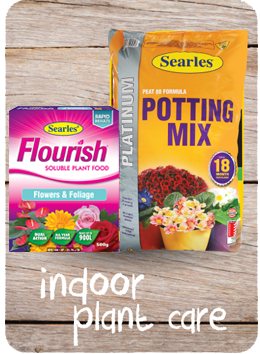INDOOR PLANT PROBLEM SOLVER GUIDE
|
Did you know that it’s now been proven that indoor plants can improve the quality of the air we breathe in our homes and offices? And that simply having them around us can have positive effects on our mood, productivity and social behaviour? (Take a squiz at www.plantlifebalance.com.au for more great information) However, for we humans to stay healthy, we need to make sure our indoor plants stay healthy too! As there’s no such thing as the “ideal” indoor plant, we need to be ever vigilant for signs that our precious ferns, figs, palms, philodendrons, devil’s ivy, dieffenbachias, aspidistras, anthuriums, zygocacti and zanzibar plants are not succumbing to changes in light levels, temperature, humidity or moisture levels inside our human spaces. Firstly, it’s vitally important that your indoor buddies are growing in the highest quality potting mix available. It needs to have good moisture holding ability but not stay too wet, have adequate controlled-release nutrition without over-supplying, and stay well-aerated for healthy root growth. Searles Platinum Potting mix is the ideal medium to provide all the right growing conditions for your plants’ roots. Secondly, make sure your plant is in the right type of pot for good growth. For good drainage and adequate aeration, choose a container that is taller than it is wide, and ensure that if repotting, move to the next size pot only. Look out for the following physical symptoms that may indicate problems with your plants’ living conditions: Sudden leaf drop – this is particularly evident in plants such as Ficus (figs) and can be caused by a move to a new location. A change in light levels, temperature (air conditioning is a common cause) or even localised air movement can trigger this response. Solution – Don’t move your plants too often! Leaf drop, yellowing, leggy growth – is a fair dinkum indication that light levels are too low. Gradually move your plants to a better-lit area or select plants that can tolerate the dingy corners of your home or office! Leaf scorch – it’s a fair bet that if this happens the light levels are far too high, or the plant has been in direct sunlight. A plant can quickly “burn” in a situation such as a north-facing sunroom that gets winter sun, but summer shade. Solution – keep plants in indirect light at all times, use suitable indoor lighting if necessary. Wilting during the day but recovering at night – a sure sign that moisture levels are getting low. You’re probably not watering often enough, maybe too little water per application, or your potting mix is too open to hold enough water for the plants’ needs. Use a moisture probe to indicate when things are drying out (your index finger is well-calibrated for this!) and think about using Searles Penetraide Re-Wetting Granules or a change to Platinum Potting Mix! Leaf drop, wilting, leaf margin damage, rot in succulents – this usually indicates that the potting mix is too wet! Can occur in shallow pots, old and decomposing potting mix, or by simply watering too often! Make sure that if using pot saucers, they aren’t always full of water. Re-pot and research your plant’s water needs. Plant gradually loses vigour, older leaves start to yellow, stunted growth – nutrition levels are falling. For instant topping-up of nutrients use Searles Flourish Soluble Plant Food. If the potting mix is still in good condition, sprinkle Searles Recharge around the tops of pots. Brown spots and leaf margin burn, white residue on surface of potting mix, wilting, strong, soft new growth – can be a sign of over-fertilising. Use clean water to flush fertiliser from the mix, then take it easy on the plant food! Follow the application directions for indoor plants on the product label. Article author: Born and bred in Toowoomba, Mike Wells has turned a lifelong passion for plants and gardening into a career as a TAFE horticultural educator for the last 18 years. This passion for all things horticulture has also seen him contribute a widely-read weekly gardening article in the Toowoomba Chronicle since 2013.
|
 |





